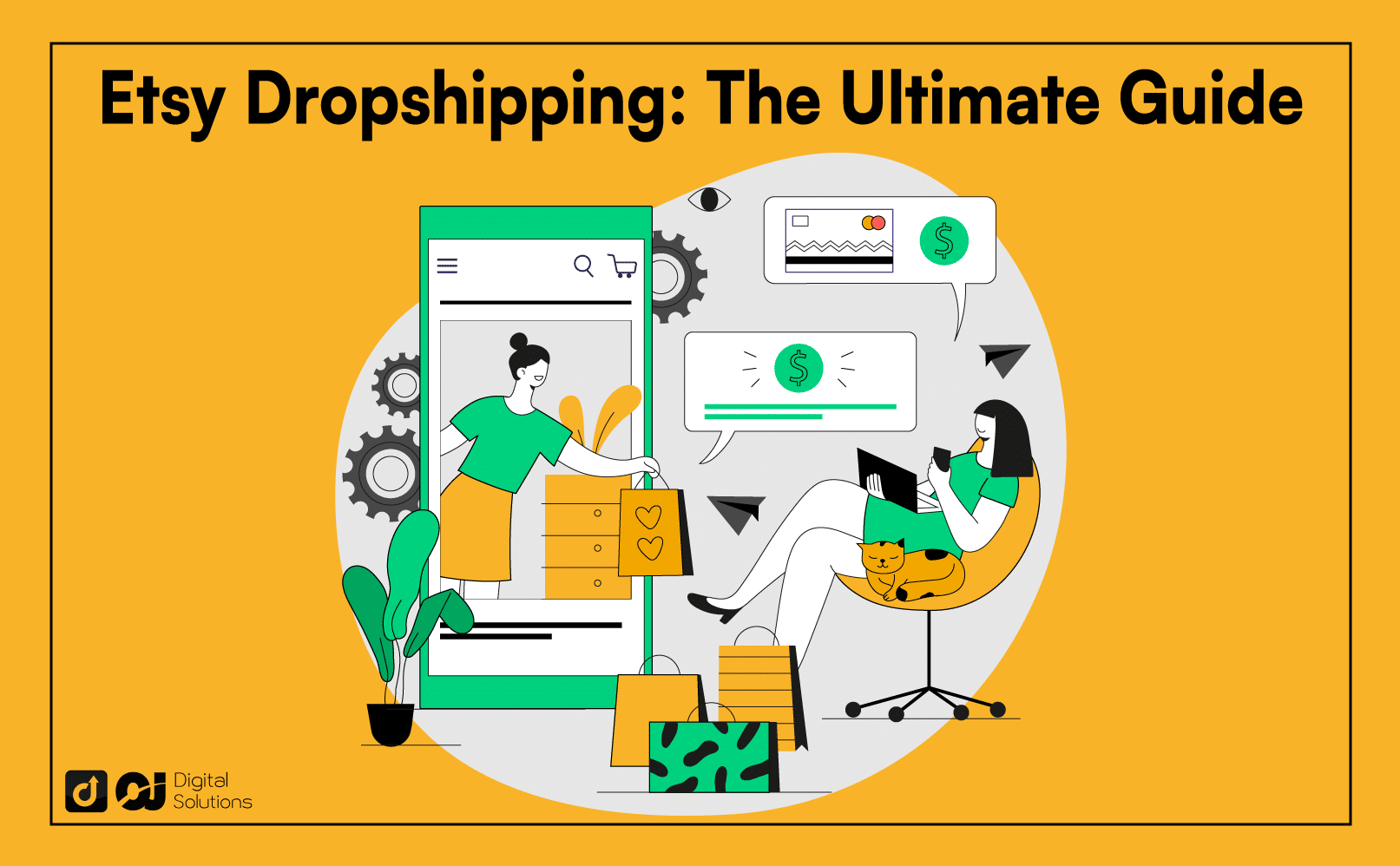Are you looking to tap into Etsy’s wide audience reach to start a dropshipping business?
This guide is for you.
With millions of sellers and buyers, Etsy presents excellent opportunities for reaching potential suppliers and customers for your dropshipping business.
Discover how to leverage the online marketplace to create a thriving e-commerce business with less financial risk and hassle.
I’ll explore the ins and outs of Etsy dropshipping, including how it works and relevant Etsy policies.
Let’s begin.
What Is Dropshipping?

A dropshipping business model is where you start your own ecommerce site while someone else handles the production and fulfillment. It involves outsourcing these processes to a third-party manufacturer or supplier:
Order packing
Delivery
Order tracking
Customer service
Returns and refunds
With a dropshipping model, you leave fulfillment the most time-consuming parts of the business to a third party. This allows you to focus on promoting your Etsy shop or other activities.
How Does Dropshipping on Etsy Work?
Note that the traditional dropshipping model doesn’t work on Etsy. It doesn’t have integration tools that will allow you to automate the fulfillment and shipping process.
However, I’ve found two ways to implement similar business models using Etsy.
Open an Etsy Store and Source Your Products From Third-Party Suppliers.

When you open an Etsy storefront, you’ll have to find products that meet the website’s standards. In general, you can sell handmade, vintage, and craft supplies.
However, you have more to consider as a dropshipper. I’ll tell you more about it in the next section.
When you find suitable products from a reliable supplier, you must manually upload each Etsy listing. The platform currently doesn’t have bulk or multiple listing tools, which means setting up your store can be time-consuming.
Once you get an order, you’ll forward their details to your supplier, who will prepare, pack, and ship the item. You may have to coordinate with the supplier to ensure they’re fine with this setup.
You have to be more involved in the process, but you won’t have to handle the inventory and fulfillment process.
Source Your Products From Etsy and Sell Them on Another Platform.

This method involves dropshipping Etsy products from Etsy merchants to resell on another platform, such as e-commerce sites, online stores, or your own website. This allows you to leverage the unique and handmade items on the platform.
Note this doesn’t have available integration tools, as well. When a customer buys from you, you’ll manually order it from Etsy and provide the buyer’s contact and shipping information.
The Etsy seller will then ship it on your behalf, but you remain the point of contact. You may have to go back and forth to relay specific inquiries and order updates.
Etsy Dropshipping Policy: Does Etsy Allow Drop Shipping?
Etsy doesn’t have specific rules for and against dropshipping. Technically, you can implement this business model, but the platform makes it challenging to do so.
Here’s an overview of the platform’s guidelines related to dropshipping on Etsy.
Policies
Reselling
Etsy allows reselling but only for vintage items and craft supplies. You can’t list an item in the handmade category if you did not make or design the product.
Curating commercial items or other sellers’ handmade goods is an example of prohibited reselling.Transparency
Your product listings must be transparent about the product’s origins and fulfillment process.Accuracy
When selling on the platform, ensure the title, description, and photos match the actual product. This can become a challenge if you’re dropshipping items from questionable sources.
Production Partners
In line with Etsy’s transparency guidelines, you should disclose any and all production partners in your product listing.
A production partner is a third-party business that you work with in different aspects of the production and fulfillment process, such as manufacturing, printing, engraving, packaging, and shipping.
This listing feature allows Etsy and customers to understand better what you’re selling and what services you’re outsourcing.
A production partner is not:
An Etsy shop owner
Your employees or Etsy shop members
Your supplier for ready-made products
As long as you disclose your business and logistical details to Etsy, you can implement a customized dropshipping model.
Eligible Products on Etsy
When you sell products on Etsy, you must familiarize yourself with what you can and can’t sell as a dropshipper.
Here’s a quick overview:
| ✅ Allowed | ⛔Not Allowed |
|---|---|
Handmade products you or a shop member designed or created | Handmade products made by another seller |
Vintage items that are at least 20 years old | Mass-produced items from wholesale websites |
Craft supplies | Items that violate intellectual property rights |
Personalized and custom-made items | General prohibited items |
Digital products you or a shop member designed or created | Fair trade or traditional handicrafts |
The Advantages and Disadvantages of Etsy Dropshipping
Understand the pros and cons of Etsy dropshipping before deciding.
| ✔️PROS | ✖️CONS |
|---|---|
| Massive Marketplace | Limited Control |
| Low Dropshipping Competition | Etsy Fees and Policies |
| Low Startup Costs | Individual Seller Policies |
| Diverse and Unique Products | Restricted Growth Potential |
| Convenience |
Etsy Dropshipping Pros
Massive Marketplace
In 2021, Etsy recorded over 96.3 million active buyers on the platform.
Its user base is a goldmine of potential customers as they’re more curated. They’re willing to wait and pay more for a handmade product or a one-of-a-kind item.
The buyers have a high purchasing intent when browsing on Etsy. If you play it right, you can easily access a market that’s ready to buy your offerings.
Low Dropshipping Competition
Dropshipping from and on Etsy is more challenging, which means fewer sellers have attempted to run this business idea.
This creates less competition, allowing you to set better prices and find more chances to stand out.
Low Startup Costs
With dropshipping, you don’t need to invest in inventory upfront. It can be a low-risk and low-cost ecommerce business, depending on the model you choose.
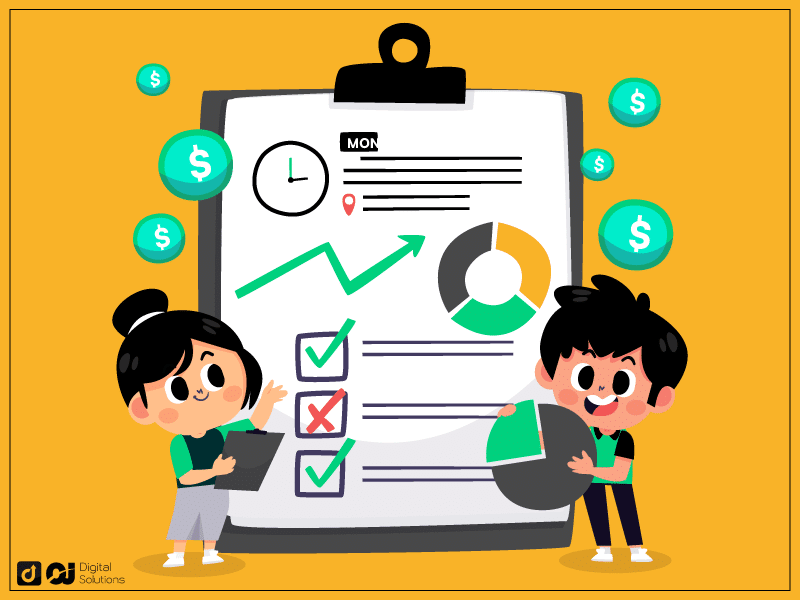
However, there are still some costs to consider, such as:
Marketing and Advertising
You may have to invest in advertising and marketing to reach a wider audience. Some costs include social media ads, influencer marketing, or Google Ads.Professional Services
You may need the professional services of graphic designers, copywriters, or web developers to help create and maintain your store.Website Setup and Maintenance Costs
If you plan to resell products from Etsy, you must pay for a basic branded website. You can build your ecommerce website on platforms like Shopify or Squarespace, which charge monthly fees.Etsy Fees
The platform charges several types of fees, which you must consider when setting a price.
Diverse and Unique Products
Etsy focuses on handmade and unique products that you won’t find anywhere else. When you dropship Etsy products, you have a chance to create a unique brand.
Moreover, the marketplace currently carries thousands of niche products. You won’t run out of options that can help you differentiate your offerings against mass-produced items.
Convenience
Dropshipping lets you offer various products without storing or managing inventory. You only need a laptop and a viable business plan to start this business.
As long as you have an internet connection, you can also run this business from anywhere.
Etsy Dropshipping Cons
Limited Control
As a dropshipper, you have limited control over product quality. You can’t oversee the production and packaging process, which creates risks like inconsistent quality and delayed shipping.
If there are issues with the products or shipping, you may need to handle customer service inquiries and refunds, which can be time-consuming and challenging.
Etsy Fees and Policies
Etsy doesn’t support dropshipping even if it doesn’t explicitly prohibit it. You won’t find any kind of support or tools that can help you manage some specific aspects of this business.
If you’re planning on dropshipping to the platform, you’ll face more challenges, specifically Etsy’s fees and policies.
The rigid rules on selling severely limit the products you can list. The common dropshipping business models won’t work on this platform, so you must customize one to fit into Etsy’s culture.
You also have to consider the applicable fees when selling on the platform, such as:
Listing fee
Transaction fee
Payment processing fee
Etsy’s fees can eat into your profit margin, which is another reason why dropshippers steer clear of the platform.
Individual Seller Policies
Aside from Etsy’s policies, you must also mind the seller’s policies, which vary from one shop to another.
Etsy shops can customize their shipping, return and refund, and personalization policies. Working with several sellers means you have to adjust your strategy to their specific requirements.
Restricted Growth Potential
The platform doesn’t have a wholesale program. Etsy doesn’t allow selling mass-produced and wholesale products because it wants the sellers to have a significant role in the item’s production or manufacturing process.
This limits your profit margins as you can’t source products at a lower cost, restricting your ability to offer competitive pricing.
It also limits your business’s scalability. You may be unable to keep up with the demand as it increases, as sellers can’t quickly churn products like large manufacturers.
Dropshipping vintage and antique items have the same challenges. The limited inventory makes it more difficult to grow your business.
How To Dropship From Etsy to Other Platforms in 6 Simple Steps
Here’s how to find products from Etsy sellers and dropship them on other platforms.
1- Conduct Product Research.
Start your Etsy dropshipping venture by exploring the Etsy Best-Sellers section for top product ideas.
You can use product research tools to find the products people search for on Etsy. Alternatively, you can check Google Trends to analyze a product’s popularity.
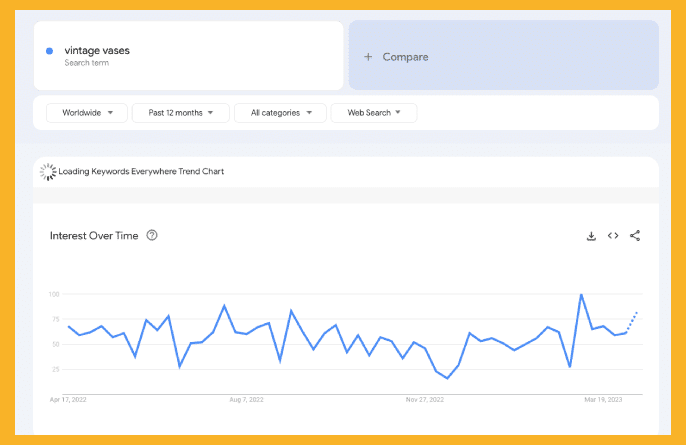
5 Best-Selling Products From Etsy
Stickers
Stickers appeal to a wide audience, especially collectors, artists, and journaling enthusiasts. They’re a versatile product that allows individuals to express themselves visually, as they can be used for customizing notebooks, water bottles, laptops, and other personal items.Wall Art Prints
Wall art prints are an easy way to enhance the aesthetics of any space. Etsy has become a go-to for this product and other home decor items because it has a wide variety of options in various sizes, allowing customers to find the perfect artwork that suits their taste and space.Beanie Hats
Beanies are also popular among Etsy customers due to their fashion appeal and functionality. If you want to offer this product, ensure to provide different style options. Find designs that stand out against the platform’s unique and handmade beanie hats.Vintage Clothing
Etsy is the best platform for vintage enthusiasts and collectors. Vintage clothing is easier to sell than bags and shoes, as they’re more accessible and diverse. You can sell t-shirts, dresses, and even accessories.Personalized Gifts
The marketplace also excels in providing custom orders more than any other platform. Etsy users appreciate the chance to give a more meaningful gift or express their individuality.
The marketplace provides various personalization options, including engraving and monograms. If you choose to dropship such items, you must find a supplier to customize orders.2- Choose a Selling Channel.

You’d want to choose a platform with massive customer base, but ensure it aligns with your business model. Although weighing the pros and cons of each option is important, you must look for a feature that can help you achieve your goal.
For example, these platforms can help you customize your online storefront and create your own brand:
Wix
eCommerce
Alternatively, you can set up a dropshipping business in an established marketplace to tap into its user base. Examples are:
eBay
Facebook Marketplace
These platforms generally work well with an Etsy dropshipping business, but you must still research the specific workings of each one.
3- Import Etsy Products to Your Store.
After selecting a selling channel, import products from Etsy to your store. Here are some methods to do this:
Manual Import.
The most straightforward approach is manually gathering the product details and photos and then uploading them to your chosen platform. This allows you to customize each listing easily, but it’s a very time-consuming process.Bulk Listing Tool.
Alternatively, you can pay for convenience. Use software that lets you import multiple listings automatically and simultaneously. It has a bit of a learning curve as you’ll have to create CSV files, but it saves you a lot of time and effort.Automatic Importer.
You can also use a dropshipping platform like AutoDS, which eliminates the hassle of manually collecting all the listing’s information. It can gather all data in one click. I’ll explain this in more detail later.
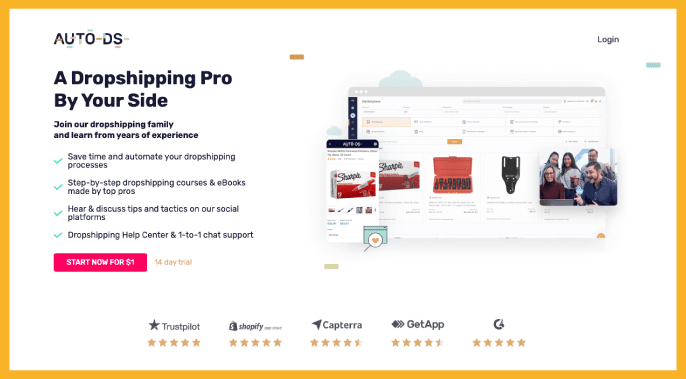
Regardless of the method, optimize your listings by using relevant keywords in the titles, descriptions, automation, and tags. Regularly review your listings to ensure all the information is up-to-date.
4- Promote Your Store and Listings.

Boost your store’s traffic by employing effective marketing techniques to create a presence on high-traffic social platforms, search engines, and forums.
Here are the best store promotion strategies.
Use social media marketing on Facebook, Instagram, Pinterest, Twitter, and LinkedIn to showcase your products and engage with potential customers.
Partner with influencers in your niche to promote your products and reach new audiences.
Create a blog with content focusing on your products and niche, incorporating keywords and backlinks to your Etsy store.
Build an Etsy email list and send newsletters, promotions, and updates.
Use Facebook or Google ads to drive traffic to your website or retarget people who visited your store.
Optimize your ecommerce store and product listings with relevant keywords, descriptions, and tags to rank higher in search results.
Team up with other businesses and sellers to cross-promote each other’s products.
Entice customers with limited-time offers, discounts, or free shipping deals.
5- Process Etsy Dropshipping Orders.
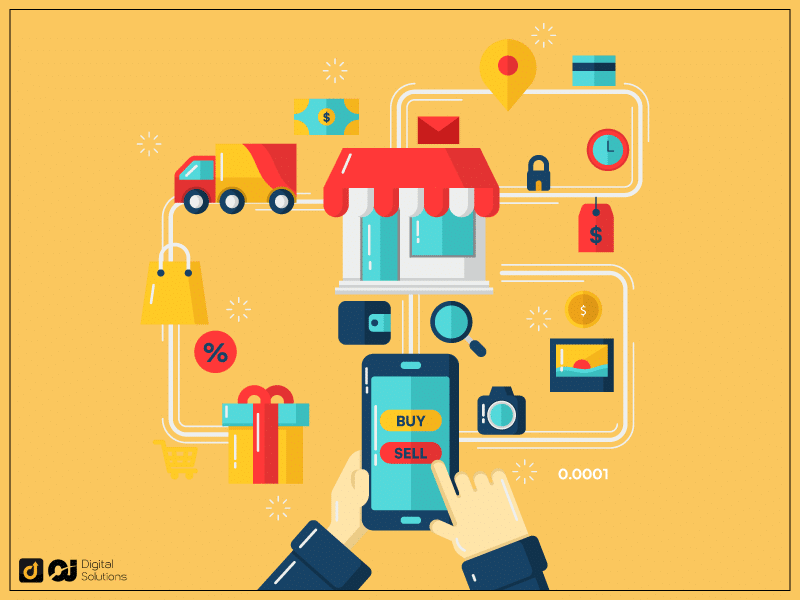
Timely order fulfillment is crucial for customer satisfaction and customer loyalty. You can find ways to automate this process using tools like Litcommerce or Fulfilled By AutoDS (FBA).
You can place orders manually, pay for Etsy products, and instruct the seller to ship products to your customer.
Although you can’t manage the shipping process, you can ensure it goes smoothly by providing accurate details and coordinating with the supplier.
6- Provide Customer Service and Support

With Etsy drop-shipping, you handle the customer service aspect. Ensure to provide the best possible experience to encourage repeat business and positive word-of-mouth.
Use these channels to help your clients and potential customers.
FAQ page
Customer management tools
Phone support
Email support
A customer ticket system
Consistently providing outstanding customer service leads to satisfied customers and fosters loyalty. These are essential to your Etsy dropshipping business’s long-term success.
Dropshipping From Etsy to Shopify
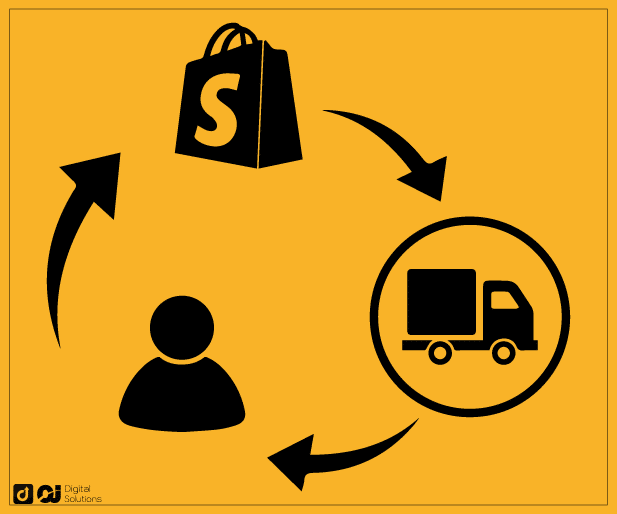
Many sellers set up a Shopify dropshipping or print-on-demand business. It has a wide user base being the third-largest e-commerce platform in the U.S.
It allows you to customize your professional-looking storefront, giving you more freedom to build your brand. The platform also has a comprehensive suite of tools to streamline the process of setting up and managing your business, including:
No-code website builder
Integrated payment options
Shipping options
If you choose to set up a dropshipping store on Shopify, here are some other things to consider:
Shopify Plans

If you want to sell on Shopify, you must create an account first. You can try the platform for free for three days, which gives you time to set up your storefront.
However, you must choose a paid plan afterward to continue using the website’s services. You have three options:
Starter
Basic
Shopify
Advanced
Shopify Plus
The main differences between the three are the features and the range of data included in the reports.
If you’re dropshipping, you can start with the Basic plan, which should have everything you need to start your business and create a branded website.
Shopify’s Features
Shopify is best known for its suite of features that can help make sellers’ lives easier, such as the following:
Bulk Listing
Inventory management
Website customization
Multiple payment gateway options
Major shipping partners
Customer support
Built-in SEO features
Marketing tools
Analytics and Reporting
The user-friendly platform can help you grow your dropshipping business. However, you must make the time to review which tools can help you streamline your processes, from sourcing products on Etsy to managing them on Shopify.
Import Tools
The platform has several tools to help you integrate your Etsy shop into Shopify, which makes migrating product data a breeze. (For more in-depth info about the difference between these two, check my Shopify vs Etsy guide.)
However, these tools don’t work for dropshipping because you don’t own the Etsy shop. You must look for a third-party solution to help you import listings more easily, such as AutoDS.
With its one-click importer feature and the AutoDS Helper browser extension, you can visit any Etsy product page and simply click the Import to AutoDS button.
This automatically transfers the product details to the platform, where you can further optimize and then publish the listing for selling to different ecommerce platforms, such as Shopify.
How To Dropship From AliExpress to Etsy
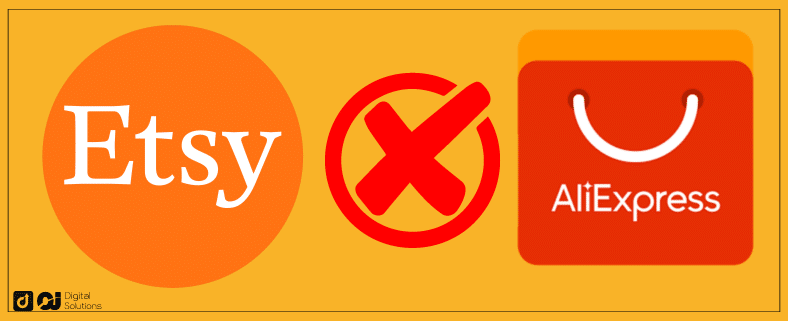
Buying from AliExpress and selling on Etsy is prohibited by the platform. The Chinese marketplace focuses on mass-produced products, the exact type of items that Etsy avoids.
However, some sellers have managed to get around Etsy’s policies by uploading custom photos instead of grabbing them from the AliExpress listings.
If you still want to try this, I’ll just lay this warning here: Etsy bans sellers from the platform if it finds out they’re doing this.
Nevertheless, AliExpress is a popular option for dropshipping. If you want to look for suppliers on this platform, you may have to a elsewhere.
Dropshipping From Amazon to Etsy
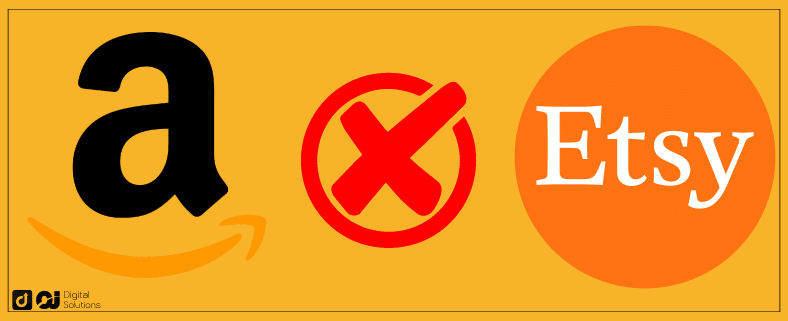
Amazon doesn’t meet Etsy’s requirements, as well. Most products in this marketplace are commercial and mass-produced.
However, many sellers have still managed to dropship from Amazon to Etsy. If you can find products that can match Etsy’s standards, you might be able to develop a successful business plan.
How To Start a Dropshipping Business on Etsy in 4 Steps
Here’s how to dropship on Etsy for new dropshippers.
1- Create an Etsy Account.
Visit Etsy’s website and click Sign in on the top right corner of the screen.
Create a new account by entering your email address, first and last name, and password.
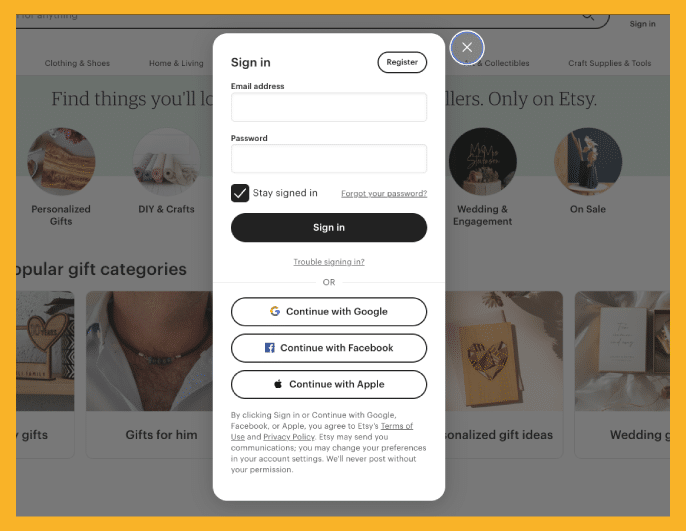
Choose a user name for your Etsy shop. Etsy requires sellers to provide basic information about their business, including their products and location.
Once you complete these steps, you can access the Etsy dashboard to add Etsy listings and customize your storefront.
2- Determine What Products To Sell on Etsy.
Finding products to sell on Etsy is your next step.
While there’s no list of Etsy-approved dropshippers (Etsy dropshipping suppliers), Etsy’s policies clearly state that not all products are eligible for sale on the ecommerce platform.

Here are the products you can sell on Etsy.
Vintage or Handmade items
The two primary product categories on Etsy are vintage and handmade products. Vintage items include anything at least 20 years old but in good condition.
Handmade goods include jewelry, clothing, accessories, home decor, furniture, pottery, and more.
Craft Supplies
If you have unused craft supplies like fabric, yarn, buttons, and beads, you can sell them on Etsy.
Digital Products
You can sell printable art, digital designs, Canva templates, patterns, and digital downloads.
Customized or Personalized Items
You can also customize your products to make them unique to your customers’ needs and preferences.
3- Find a Dropshipping Supplier.
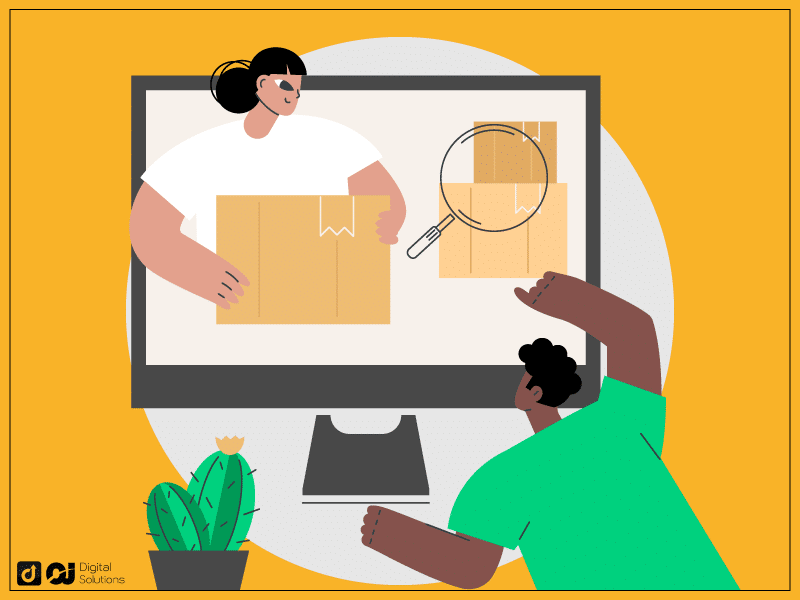
Because Etsy doesn’t support dropshipping, you’ll have to look for a vendor yourself. Your best bet is looking for established businesses who can manage several orders.
You can find Etsy suppliers through trade shows, online directories, and networking.
You may also consider Etsy print-on-demand services, which Etsy fully supports. You can integrate these with the platform, allowing you to automate the order fulfillment process. They will print, pack, and ship your orders for you.
Some popular POD providers on the platform are:
Printify
Printful
CJDropshipping
- Yoycol
4- Forward Orders to Your Dropshipping Suppliers.

To dropship products from a third-party seller to Etsy, you must provide them the details of the product sold on your store. Check orders regularly to avoid missing orders.
Some suppliers have built-in integrations with your Etsy store, allowing orders to go from your shop backend to your supplier. You can focus in promoting your products in other channels.
However, this only applies to print-on-demand services.
Frequently Asked Questions (FAQs)
Can You Do Dropshipping With Etsy?
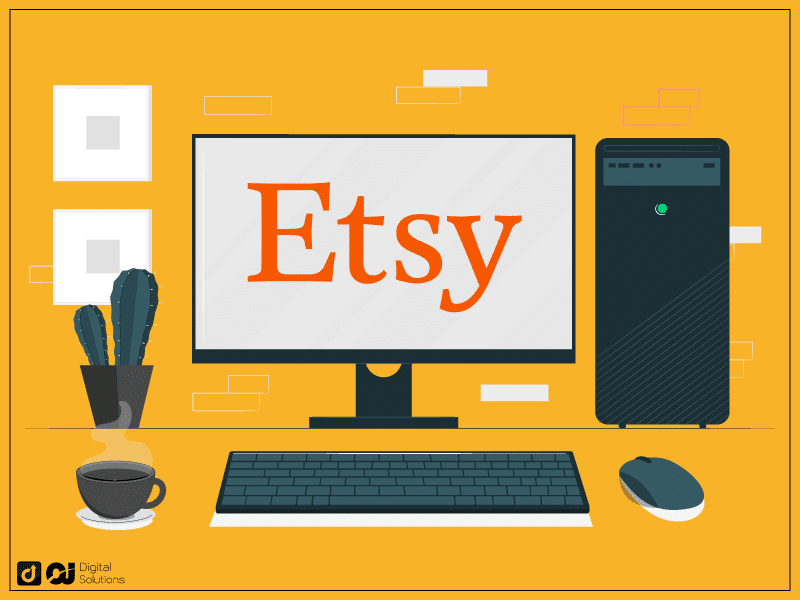
Can you dropship on Etsy? There are no hard fast Etsy dropshipping rules in place, but the platform has specific rules about which products you can sell on the platform.
Etsy’s product policies permit resale, meaning dropshipping is legal if the products meet specific criteria, including handmade products, antique items, or craft supplies.
Is Etsy Dropshipping Worth It?

Etsy isn’t the best platform for this business model, but several have become successful after customizing the traditional dropshipping template.
Conduct thorough market research and assess the competition to see if this venture aligns with your goals and resources. If the benefits of selling on Etsy outweigh the disadvantages for you, it can be a worthwhile business.
Can I Connect My Etsy Dropshipping Store to Shopify?

Yes. You can integrate Shopify with Etsy if you already have an Etsy store.
Migrate your store from one platform to another or maintain your store on both platforms.
Integrating these platforms offers sellers several benefits, including synchronizing inventory and simplifying managing both platforms.
You can also export and import items to update your listings on both platforms and manage your orders and billing, especially if you registered both shops under the same name.
Here are the three ways to manage stores on both platforms.
Use the Etsy Marketplace Integration. With this Shopify app, you can manage your inventory, orders, listings, and more on Etsy.
Use Etsy Integration: Sync & Sell. This Shopify app also helps sync your Etsy and Shopify listings and helps you sell Etsy products on your Shopify store seamlessly.
Use Etsy Connector. This app lets you sync products on both platforms.
How To Sell on Etsy Without Inventory?
You can start an Etsy shop without inventory through two main methods:
Dropshipping. You can partner with third-party suppliers to manage order fulfillment for you. All the other business aspects fall on you, from creating listings to providing customer support.
Print-on-Demand Service. It’s similar to dropshipping in that a POD service will manage and ship the order to the customer on your behalf. The only difference is that you have to upload designs, which requires a level of creativity.
Can You Resell on Etsy?
Yes, Etsy allows reselling under these conditions:
Vintage or Craft Supplies Category Only. Etsy doesn’t allow reselling products in the Handmade category.
No Bundles or Repackaging. You can’t resell repackaged commercial items or handmade products you didn’t make. Rebranding commercial items isn’t also allowed.
No Products Designed by Another Etsy Seller. Unless they are a part of your shop, in which case it’s not reselling.
No Fair Trade Items or Traditional Handicrafts. If you plan to sell in these categories, you must design or make the product yourself.
Etsy can and will remove listings that don’t follow their policies.
The Bottom Line
Etsy is a unique and vibrant online marketplace that offers sellers an excellent opportunity to reach a global audience and showcase their handmade, vintage, or craft supply products.
If you plan to dropship on Etsy, you should tread carefully and ensure you’re legally clear. Understand the costs of selling on Etsy, such as fees and shipping expenses.
Although dropshipping on the platform can be challenging, you can turn it into a profitable business with dedication and hard work.

